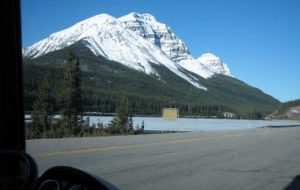In addition to navigating steep grades, RV mountain driving comes with a few unique hazards. Let’s take a look at some.
While wildlife can be encountered on many highways, some mountain roadways have an additional animal, the mountain goat, that often wanders on the road. Rugged terrain can also make the road edge an appealing passage for wildlife on the move. Combine this with the twisty roads and reduced forward view, a shorter warning of wildlife is to be expected.
Rock slide warning signs are common in the mountains. While a rock slide is highly unlikely, the possibility of encountering some small rock pieces on the roadway can be very real, particularly after a heavy rainfall. These rock fragments are jagged and can damage or destroy a tire. Reducing speed when such warning signs are posted can increase your maneuvering and stopping ability.
When operating in mountain ranges that are snowcapped, precipitation can be encountered even on a clear day. This can happen when humid air drifts across the snowcaps. The snow reduces the air temperature to, or below, the dew point. At this temperature, some cloud formation may appear and snow or fine rain may fall. This can result in a fog-like driving experience and possible slippery road surfaces. Similar conditions can be found if the roadway rises up to, and through, the cloud base, and vision may be reduced to near zero. Slow down and observe caution.
Unlike most roadways found in the lowlands, mountain roads occasionally have no shoulders or guardrails. These require special care and attention. Wandering off the road in these areas can have disastrous results.
Climbing steep grades takes horse power and torque; this causes the drivetrain to heat up. To keep your engine and transmission running cooler, climb grades in a manually selected gear. This then will allow partial throttle climbs without the automatic up-shift. Operating your engine at higher RPM will allow the cooling package to run more efficiently during hard pulls.
 Generally, there is little affect to most people when exposed to 5,000 feet or so. But there are far higher elevations in the U.S. that you can drive to about 12,000 feet or more. If you are planning a trip that may take you to these extreme elevations, it would be wise to look into altitude health effects for yourself and those traveling with you.
Generally, there is little affect to most people when exposed to 5,000 feet or so. But there are far higher elevations in the U.S. that you can drive to about 12,000 feet or more. If you are planning a trip that may take you to these extreme elevations, it would be wise to look into altitude health effects for yourself and those traveling with you.
If you camp in the mountains, you should be aware of the reduced output that your generator can supply. For each 1,000 feet of elevation above sea level, a 3.5% drop in output will be experienced. So, for example, if you have a 7,000 watt unit, you will only have about 5,500 watts at 6,000 feet.
Well, those are just some of the challenges you may face when traveling through mountainous regions. The geographic beauty, however, is well worth it. Be Safe and enjoy!






Ken Zuk
All good advice, too bad so many drivers (Alberta / BC, Canada) do not understand this and still try to do 100kms+ on the roads. Generator, see your manufacturer, a lot of them come with a special carburetor adjustment screw for high altitudes to offset this to about 1/2 the loss. Hint here, if generator, turn your fridge off of auto when running generator.
Bill Miller
Good comments